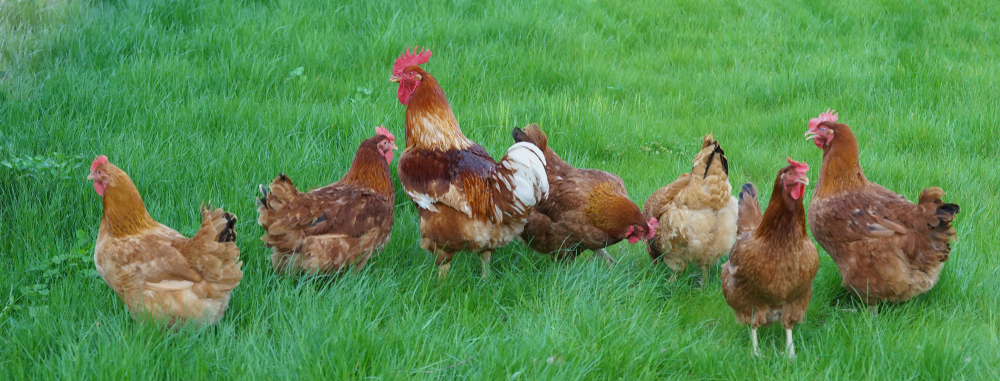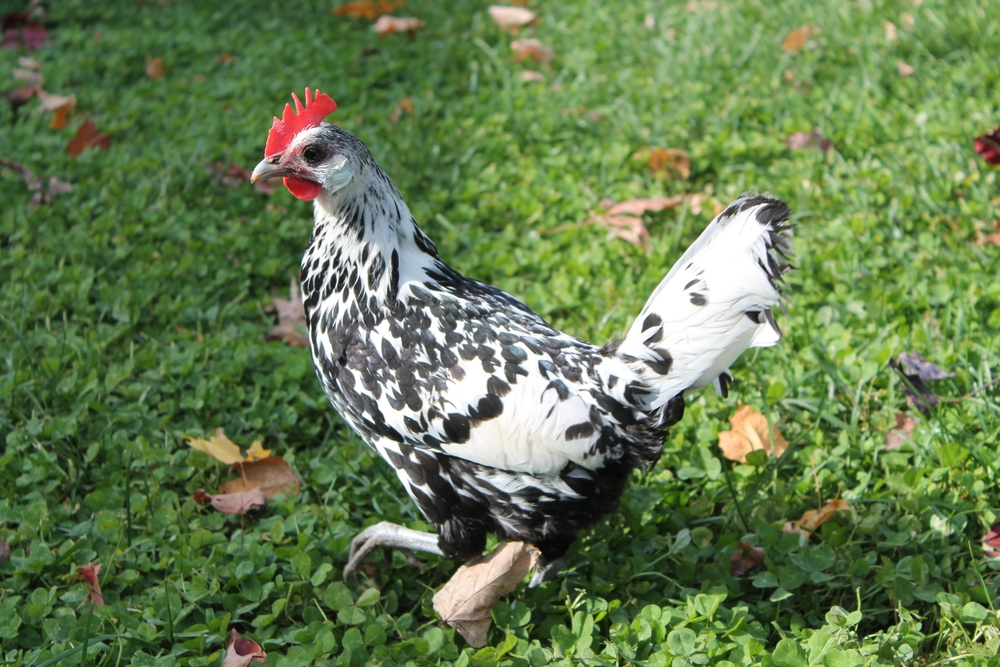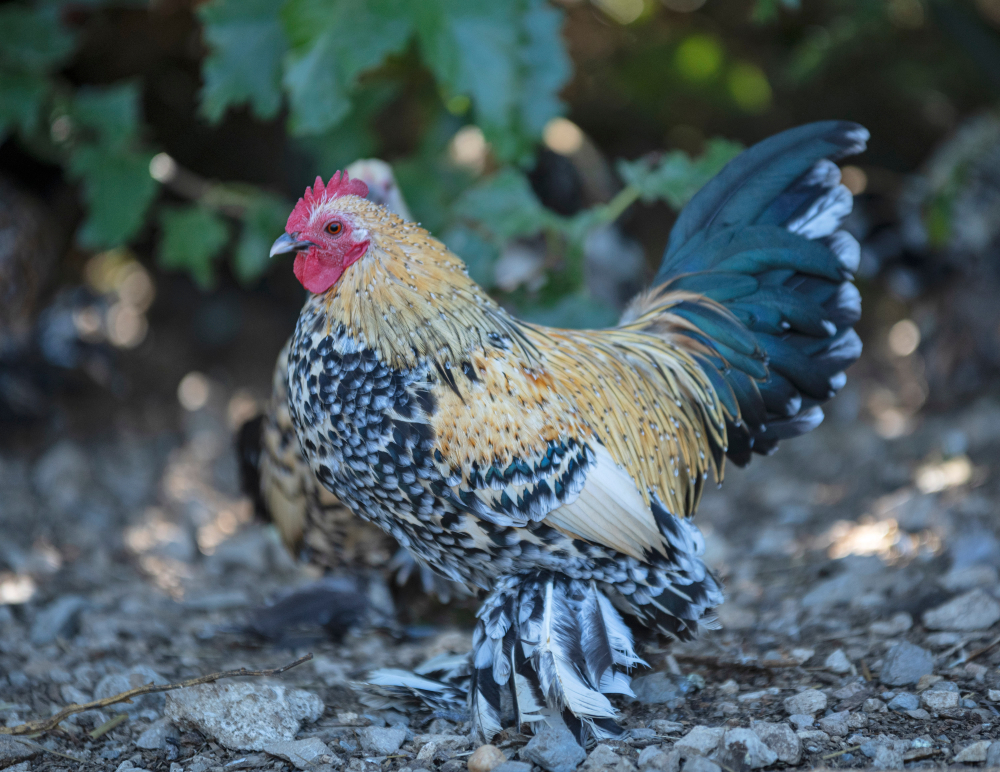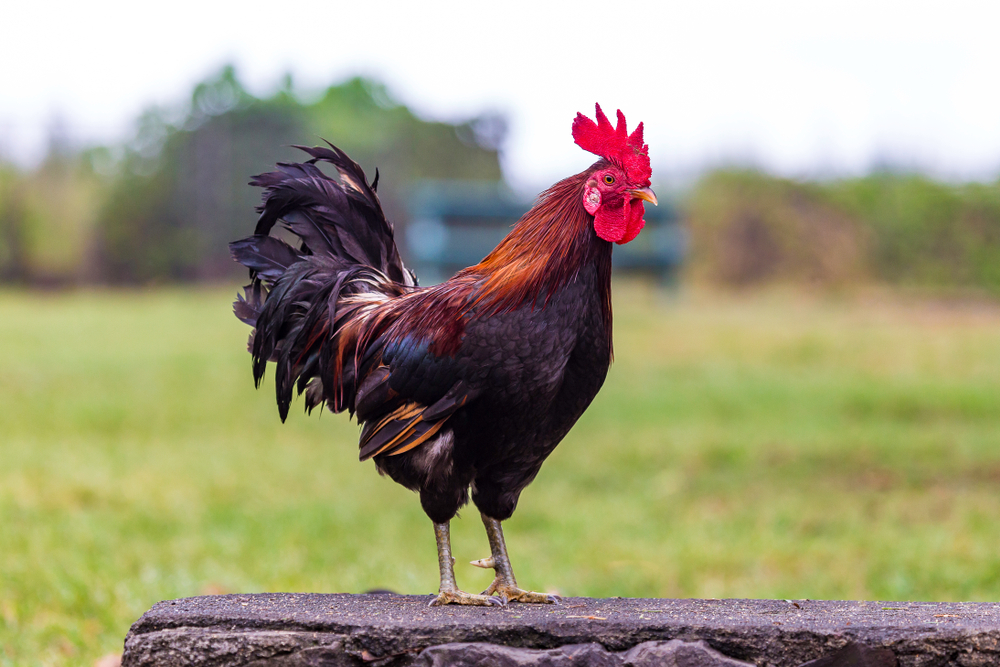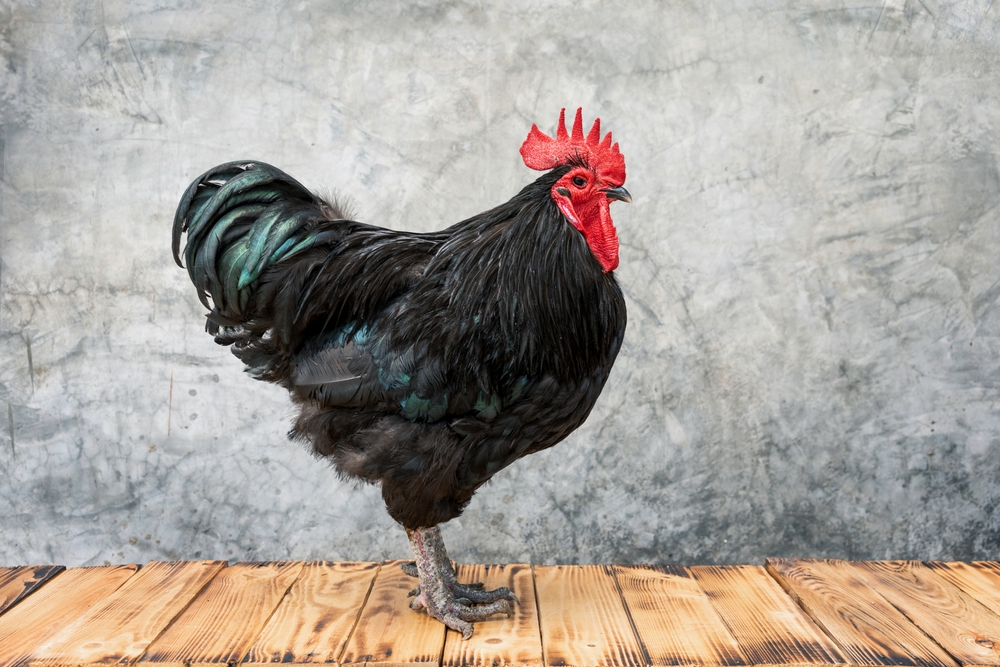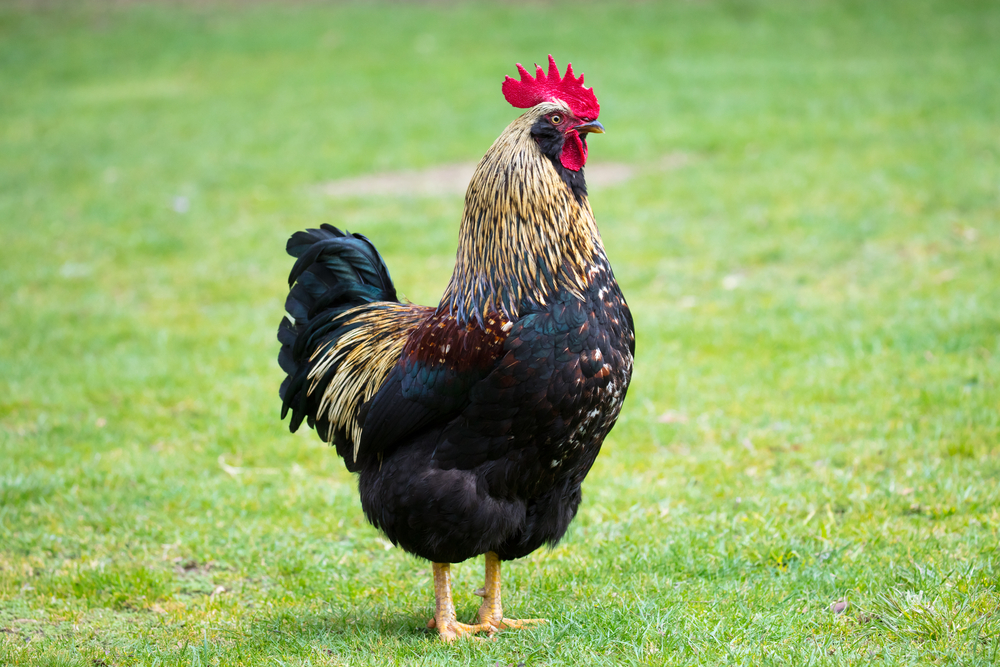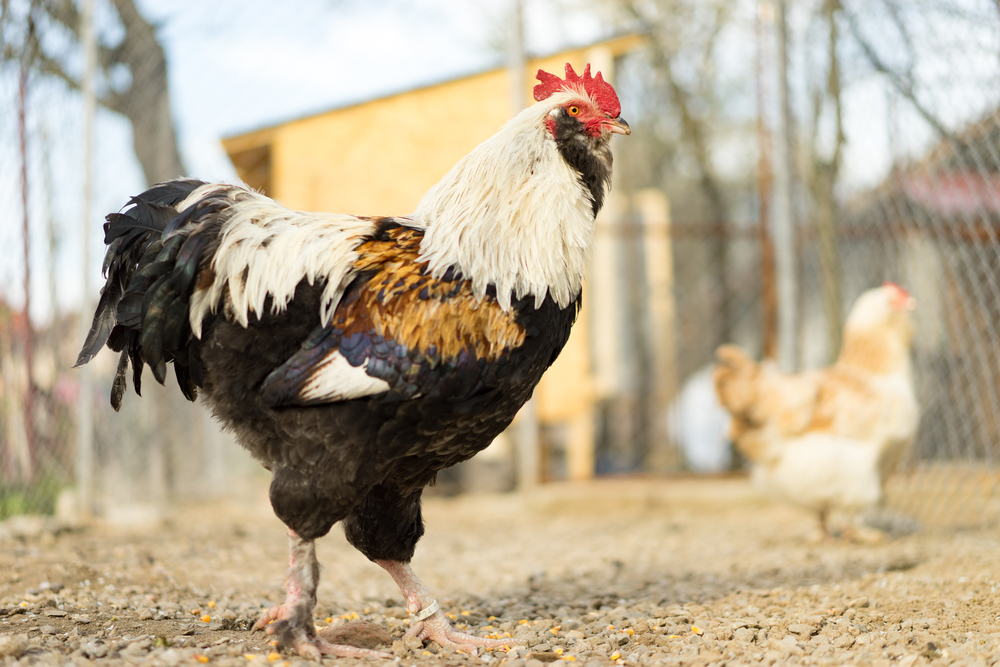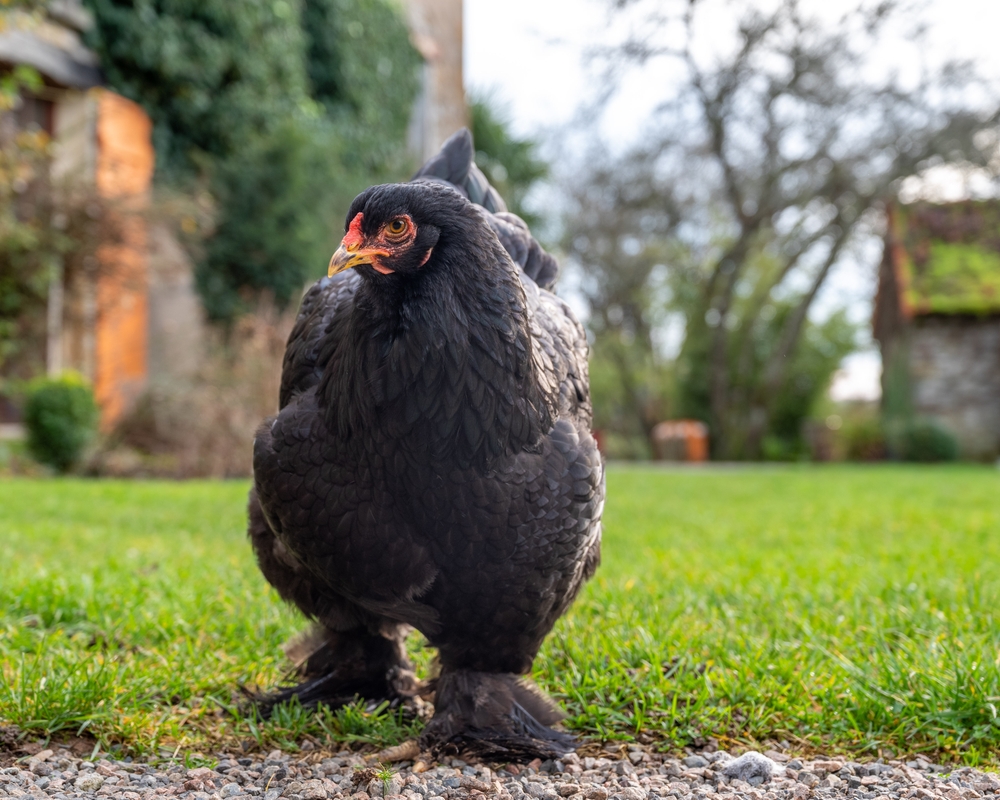The closest relative to the Hampshire Red is the Rhode Island Red, from which it shares much of its heritage. Both are American-developed, red-feathered dual-purpose breeds, but the Hampshire Red typically has a slightly deeper mahogany color, a somewhat heavier frame, and was bred for more balanced meat and egg qualities rather than maximum egg output.
About
The Hampshire Red is a heritage dual-purpose chicken breed developed in the United States, closely related to the Rhode Island Red but selected for faster maturity and efficient meat and egg production. While less common today due to the rise of industrial hybrids, the Hampshire Red was once a popular choice for small farms seeking a hardy, productive bird.
Medium to large in size, roosters typically weigh 3.4–3.9 kg (7.5–8.5 lbs) and hens about 2.7–3.2 kg (6–7 lbs). Their plumage is a rich, deep chestnut red, often a shade lighter than the darker mahogany of the Rhode Island Red, with a clean, glossy appearance. They have a single upright comb, red wattles, and yellow legs, giving them a classic farmyard look.
Hampshire Reds are good layers, producing 200–250 large brown eggs per year. They are also valued for their quality meat, with a well-fleshed carcass and mild flavor. The breed’s early maturity made it especially attractive for farmers wanting a quicker turnaround from chick to table or egg production.
They are active foragers and perform well in free-range systems, but they also adapt to confinement if given adequate space. Known for their hardiness, Hampshire Reds tolerate both hot and cold climates and remain productive across varying conditions.
While calm and generally docile, they can be more spirited than some purely ornamental breeds. Today, pure Hampshire Reds are rare, and many existing birds labeled as such are crossbred for commercial purposes.
The Hampshire Red’s scientific classification is Gallus gallus domesticus, and it belongs to the family Phasianidae.
Physical Characteristics
Plumage:
Hampshire Reds are characterized by their rich, deep red plumage with a uniform, glossy sheen across the body. The feather color is typically darker than that of production-focused Rhode Island Reds, leaning toward a deep mahogany tone. Feathers lie close to the body, providing a sleek yet full appearance.
Head and Comb:
The head is medium-sized with a single, upright comb of 5 well-defined points, though some lines may carry a rose comb. The comb, wattles, and earlobes are bright red, contrasting sharply with the dark plumage. The beak is short, strong, and yellow to horn-colored. Eyes are reddish-orange, offering sharp vision for foraging.
Body:
Hampshire Reds have a broad, deep body with a well-rounded breast and strong back. The build is slightly heavier than some other red-feathered breeds, reflecting their dual-purpose heritage for both eggs and meat.
Legs and Feet:
The legs are clean (feather-free), strong, and yellow, with four well-spaced toes on each foot. The shanks are sturdy enough to support their moderately heavy frame.
Tail:
The tail is moderately full and carried at a slight upward angle. Roosters have well-curved sickle feathers with a greenish-black sheen, while hens’ tails are shorter and more compact.
Size:
-
Male Weight: 8 to 8.5 lbs (3.6 to 3.9 kg)
-
Female Weight: 6.5 to 7 lbs (3 to 3.2 kg)
Sexual Dimorphism:
Males are larger, with longer and more iridescent tail feathers, more pointed hackle and saddle feathers, and a more upright stance. Females are rounder in body shape with slightly shorter legs and tails.
Hampshire Reds’ combination of deep mahogany plumage, balanced dual-purpose build, and robust frame makes them a striking and practical heritage chicken breed.
Reproduction
Mating Behavior:
Hampshire Reds are generally calm and steady in temperament, making them easy to manage in breeding flocks. Roosters are attentive but not overly aggressive, and hens accept mating readily in well-balanced groups. A typical breeding ratio is 1 rooster for every 8–10 hens to maintain fertility without overbreeding.
Breeding Season:
While capable of breeding year-round in mild climates, Hampshire Reds are most reproductively active in spring and early summer. In cooler climates, they remain productive layers and breeders well into the autumn months.
Egg Laying:
Hampshire Reds are solid egg producers while maintaining good meat qualities.
-
Annual Output: Around 200 to 250 large eggs per year.
-
Egg Color: Brown to light brown.
-
Egg Size: Large.
Hens tend to maintain steady egg output in various conditions, including moderate cold.
Broodiness and Incubation:
-
Hampshire Reds show low to moderate broodiness, meaning many hens prefer to keep laying rather than setting on eggs.
-
When they do go broody, they are attentive and protective mothers.
-
Incubation Period: About 21 days, with hens turning eggs regularly and keeping steady warmth.
Chicks:
-
Appearance at Hatch: Fluffy, often reddish-brown to golden with lighter underbellies.
-
Self-Sufficiency: Active within hours, quick to begin pecking and foraging.
-
Growth Rate: Moderate to fast, with chicks feathering out quickly and reaching good table weight in a reasonable time.
Maturity:
Hens typically begin laying at 5 to 6 months, while roosters reach full breeding capacity around the same age.
Hampshire Reds’ good fertility, reliable egg output, and balanced meat qualities make them a dependable choice for small farms and backyard breeders seeking a dual-purpose heritage bird.
Lifespan
Lifespan in the Wild/Farm Setting:
As a domesticated heritage breed, Hampshire Reds are typically kept in backyard or farm environments. With standard care, they generally live 5 to 7 years, with peak egg production occurring in the first 3 to 4 years before gradually declining.
Lifespan in Optimal Conditions:
With excellent nutrition, predator protection, and proactive veterinary care, Hampshire Reds can live longer than the breed average.
-
Average Maximum Lifespan: 8 to 10 years
-
Exceptional cases: 10+ years, particularly when kept more as ornamental or breeding birds rather than for heavy production.
Threats to Longevity:
-
Predation: Common predators include foxes, raccoons, hawks, owls, and domestic dogs, especially in free-range systems.
-
Reproductive Strain: High egg output can lead to reproductive tract issues, such as egg binding or prolapse, in later years.
-
Parasites and Disease: Susceptible to lice, mites, worms, and respiratory diseases without preventative care.
-
Environmental Stress: Extreme heat or cold, poor ventilation, or overcrowding can shorten lifespan.
Adaptations for Longevity:
Hampshire Reds are hardy and adaptable, tolerating a variety of climates and continuing to lay in cooler weather. Their strong immune systems and robust body type contribute to longer life expectancy when cared for properly.
Eating Habits
Diet:
Hampshire Reds are omnivorous foragers, thriving on a combination of commercial poultry feed and naturally sourced foods.
-
Primary Feed: High-quality layer pellets or mash with 16–18% protein, plus added calcium for strong eggshells.
-
Foraged Foods: Insects, worms, seeds, tender grasses, weeds, and small invertebrates found while scratching.
-
Treats and Supplements: Whole grains (corn, wheat, oats), leafy greens, vegetable scraps, grit for digestion, and oyster shell or limestone for calcium.
Feeding Behavior:
-
Hampshire Reds are active and efficient foragers, covering ground steadily in search of food.
-
They are generally calm at feeding stations, though roosters may call hens to food with tidbitting sounds.
-
They require constant access to fresh water, especially during peak laying periods.
Foraging Times:
-
Most active in the morning and late afternoon, resting or dust-bathing in midday heat.
-
In hot climates, they may seek shaded areas for foraging during warmer hours.
Adaptations for Feeding:
-
Strong, sturdy beaks suited to cracking seeds and dislodging insects from soil.
-
Balanced energy levels make them productive foragers without excessive feed consumption.
Captive Diet Management:
-
In confinement, a steady supply of nutritionally complete feed ensures consistent egg production.
-
Overfeeding grain treats can lead to weight gain and reduced laying performance.
Hampshire Reds’ efficient foraging skills, adaptability to various diets, and calm feeding habits make them easy keepers for both backyard flocks and small-scale farm systems.
Uniqueness
Balanced Dual-Purpose Design:
Hampshire Reds are valued for their ideal balance between egg production and meat quality. Unlike some red-feathered breeds developed purely for laying, they retain a broad frame and good muscle development, making them a true dual-purpose bird.
Distinctive Deep Red Plumage:
Their rich mahogany-red feathers set them apart from lighter-toned breeds like New Hampshire Reds or commercial hybrids. This darker color is often uniform across the body, giving them a polished, heritage appearance.
Hardy and Adaptable:
Bred for New England conditions, Hampshire Reds thrive in cooler climates and maintain egg production in cold weather, making them dependable year-round layers.
Calm and Manageable Temperament:
They are known for being docile, steady, and easy to handle, making them suitable for mixed flocks and family farms. Roosters are generally protective without excessive aggression.
Good Egg Consistency:
While not the very top producers in sheer numbers, Hampshire Reds excel in consistent laying of large brown eggs over several years, outperforming many breeds in long-term productivity.
Heritage Breed Status:
As a lesser-known American heritage breed, Hampshire Reds are valued by poultry enthusiasts for their history, resilience, and preservation potential in sustainable farming systems.
The Hampshire Red’s heritage bloodlines, adaptability, and balanced productivity make it a practical yet attractive choice for keepers who want both performance and tradition in their flock.
Be the First to Share Photos of This Species.
FAQ’s
1. What is the closest species to the Hampshire Red?
2. How does the Hampshire Red compare to other chickens?
The Hampshire Red differs from other breeds in several ways:
-
Color: Darker, richer mahogany plumage compared to lighter-toned New Hampshire Reds.
-
Utility: Balanced for both meat and egg production, unlike many modern layers bred only for high egg count.
-
Hardiness: Adapted to cooler climates with strong year-round productivity.
-
Temperament: Calmer and more manageable than some high-energy layers like Leghorns.
-
Egg Size: Produces large brown eggs more consistently over several years than many commercial hybrids.
3. What national parks provide the best chances to see a Hampshire Red?
As a domesticated heritage breed, Hampshire Reds are not found in the wild, but they may be seen in heritage farms, agricultural history sites, and rare breed conservation programs, such as:
-
Billings Farm & Museum (Vermont, USA)
-
Colonial Williamsburg Rare Breeds Program (Virginia, USA)
-
Old Sturbridge Village (Massachusetts, USA)
-
Shelburne Farms (Vermont, USA)
-
Sovereign Hill (Victoria, Australia)
These sites preserve and showcase heritage poultry breeds like the Hampshire Red as part of agricultural education programs.



































































